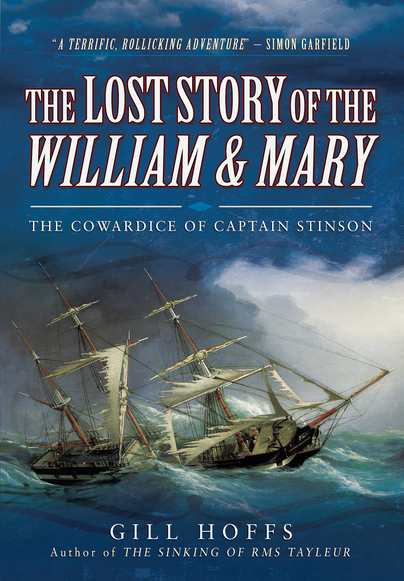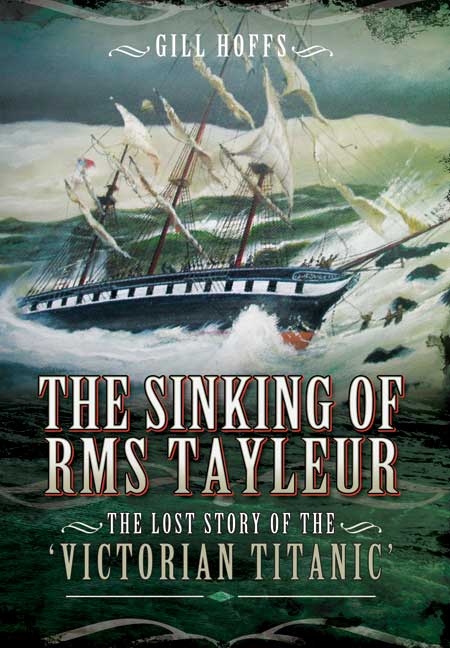The Lost Story of the William and Mary (Hardback)
The Cowardice of Captain Stinson
Imprint: Pen & Sword History
Pages: 162
Illustrations: 10
ISBN: 9781473858244
Published: 19th September 2016
Publicity
'I loved the salty air of Gill Hoffs' book. A terrific, rollicking adventure that will stay long in the memory.'
– Simon Garfield, author of Timekeepers, editor of A Notable Woman: The Romantic Journals of Jean Lucey Pratt
As seen on ITV's Granada Reports.
As referenced by the Irish Examiner: Lambay's avenue of mysteries
The Best Articles of 2017 by History Today - Lost at Sea: The Dangers of Emigration by Gill Hoffs
(click here for international delivery rates)
Need a currency converter? Check XE.com for live rates
| Other formats available - Buy the Hardback and get the eBook for free! | Price |
|---|---|
| The Lost Story of the William… ePub (12.1 MB) Add to Basket | £6.99 |
“[S]he struck against a reef … the scene which then took place was fearful in the extreme. The passengers came rushing up the hatchways, some in their night-clothes, and all in the greatest disorder, screaming and wringing their hands frantically, while the ship kept rolling from side to side with the greatest violence, sometimes appearing as if she would have gone on her beam ends altogether...” Ebenezer Miller, passenger. (Preston Chronicle, Saturday 11 June 1853.)
The loss of the emigrant ship William & Mary made news around the world not once but twice in 1853. First when her American captain reported the vessel lost before his eyes in the shark-infested waters of the Bahamas and the death of over 200 left on board, then again when the truth emerged – a tale of abandonment, desperation, and the incredible heroism of a wrecker and his crew. Discover the people involved in this mysterious shipwreck, including:
Captain Timothy Stinson, the callous young mariner who attempted mass murder
Susannah Dimond, the English 19-year-old hoping for a new life in St. Louis with her family, husband and unborn child
Izaak Roorda, one of a group of 87 Dutch emigrants seeking to settle in Wisconsin, who found the lifeboat more perilous than the sinking ship
Over 160 years later, Gill Hoffs reveals the terrifying true events that drove one man to murder passengers with a hatchet and others to abandon their family and friends – and a wrecker to risk his life for total strangers.
It's a deeply moving story, and Hoff tells it well. Where details are scarce, she borrows narratives from similar events to fill in the gaps.
Rambles
Read the full review here
As mentioned by
Warrington Guardian, 28th June 2018
I believe Hoffs has succeeded in telling a story for those who were not able to tell it themselves.
The Northern Mariner, April 2017 – reviewed by Wayne Abrahamson Pensacola, Florida
Author article as featured in, on the subject of her book
History Today, April 2017
As featured online at History Today!
History Today
There is a new series of history books, products of the internet age, that have amateur historians putting together works that are, often, better than those by professional historians. The reason for the success of these amateurs is simple. They concentrate on contemporary sources, sources that are now increasingly available online for those ready to search, writing with the values and often the elegance of their nineteenth-century predecessors. Gill Hoffs’ The Lost Story of the William & Mary is very much part of this emerging tradition. The book describes a disastrous (though not catastrophic) Atlantic crossing, which came to grief in the Bahamas in 1853. GH has stretched the few contemporary documents that we have for this event, newspapers and diaries in Dutch, to breaking point, but the book works. Admittedly, GH resorts to the stratagem of finding different but similar events from other boats, employing these to give atmosphere. Here we see, though, her art. These supplementary passages add tension to the claustrophobic holds of the William and Mary. The details are difficult to forget: making pancakes in rinsed out chamber pots, pig faeces dripping on sleeping crewmen’s faces, a ring thrown at a fleeing husband and a fork… (Even if Beach, in the rages of some future dementia, forgets everything else about this book, he’ll still remember the fork. Let’s hope it is still rattling at the back of some drawer in middle America, a long way from the sea that almost consumed it.)
Strange History
Read more here.
I found myself engrossed in this story. It is a book that I was interested in and enjoyed and I would thoroughly recommend it to readers of The Naval Review. It is an easy, accessible story of the hazards of migration by sea; a story, alas, all too familiar today (and often with the same reactions; press and public outrage, but little from officialdom). Many migrants seem to have written home to newspapers, describing their journeys, so that others would at least be forewarned. Hoffs has done a good job in weaving the story of the William & Mary into a wider description of the dangers and privations of migration in the nineteenth century, making selected use of newspapers and diaries to give first hand accounts of the voyages.
The Naval Review, February 2017 - reviewed by Andy Field
In the accounts shared, Hoffs keenly shows the difference in value placed on human life versus that of livestock. She crafts a heart-wrenching and vivid tale composed primarily from firsthand accounts that allows readers to envision the terrifying journey these people endured. She also shares what happened to those survivors whom she could track through a variety of sources including contemporary newspapers, survivors’ stories, later articles on the disaster, and family histories. Instead of simply names on the page, these people come alive.
Pirates and Privateers, Cindy Vallar
But this book is far more than just the story of this ship and those aboard her. Hoffs enriches the story with accounts from other passages and descriptions to provide readers with a fuller understanding of conditions that led to emigration, what such journeys were really like, and what occurred in the aftermath of the accident and the shameful behavior of those who escaped unscathed. In doing so readers gain a better appreciation for the dangers their own ancestors may have faced to make a new life in a new land.
Read the full 5 Star review online here.
The Lost Story of the William and Mary: The Cowardice of Captain Stinson is an excellent book, something that will not surprise anybody who has read Hoffs’s previous non-fiction offering, The Sinking of the R.M.S. Tayleur. It is apparent that the writer knows her subject from an strictly intellectual point of view (in that the research is meticulous), but moreover that she understands her subject at an emotive level.
Kevin Bufton, Storyteller
Read the full review here.
Overall the book offers a detailed description of Victorian emigration, leading to an explanation of how the system worked, most notably in Liverpool. The finer points of this, and other similar journeys and shipwrecks highlight the main narrative. Hoffs research is extensive; over two hundred newspapers were used, although she does state that this has been done primarily through the internet. The author also used many eye-witness accounts and the final chapter twelve, rounds off the book nicely with a history of those who survived the voyage.
The Historical Examiner
Read the full review here.
The Lost Story of the William and Mary is a specific and well-researched glimpse of tragedy that becomes a case study of humanity and the roles of good, evil, and ineptitude. Not insignificant are the ways in which this book speak to the global realities of our present-day, twenty-first century. Vast numbers of people around the globe continue to suffer, for an array of torturous reasons, and will seek safety and escape where it is offered. Who will help? Who will stand in their way? Gill Hoffs is a hero for exposing lost truths. May we learn from them. May we continue to lift up the stories of those less fortunate, especially of people with no appreciable means to be heard.
Kari Nguyen's Writing
Read the full review here.
More than 160 years later, this incredible story has resurfaced as Gill Hoffs dons her detective hat to uncover the truth of the emigrants' terrifying experience and the captain and crew's cowardice and lies, which went unpunished. Using a variety of sources such as contemporary newspaper reports, letters and diaries, plus information from descendants, she has pieced together a remarkable tale of its time and ours.
Family Tree, January 2017
Gill Hoffs’ recounting of the fate of the William and Mary is more than just a story of the events that led up to the controversial day in which Captain Timothy Stinson would abandon the passengers to their fate and then lie about what happened. It is the contexts Hoffs provides throughout that adds crucial dimension to the story...
Paul Vicary, Freelance
Hoffs makes impressive use of newspaper articles of the time (European as well as American) as well as letters from surviving passengers, weaving accounts throughout the narrative, providing a rich context of life in 19th century Liverpool as well as of the travails of travel on transatlantic passenger ships; travails suffered especially by those escaping the wretchedness of economic privation.
Prepare to be transported to the decks of the William & Mary and travel with the passengers and crew on this so fateful journey from Liverpool to New Orleans. Countless research has gone into finding out the true facts behind the story of this emigrant ship and Hoffs has to be congratulated on the detail she includes. A fascinating read and one which will take you on a journey that you could never begin to imagine.
Suzie Lennox, Author
The loss of the emigrant ship William & Mary made news around the world, not once, but twice in 1853. First, when her American captain reported the vessel lost in the shark-infested waters of the Bahamas and the death of over 200 left on board, then again when the truth emerged a tale of abandonment, desperation, and the incredible heroism of a wrecker and his crew. This book shines light on some of the people involved in this maritime disaster, including: Captain Timothy Stinson, the callous mariner who attempted mass murder; Susannah Dimond, the English 19-year-old hoping for a new life in St. Louis with her family; and Izaak Roorda, one of a group of 87 Dutch emigrants seeking to settle in Wisconsin, who found the lifeboat more perilous than the sinking ship.
Action-Adventure Historical Fiction, Julian Stockwin
In her latest book, "The Lost Story of the William & Mary," Gill Hoffs does a wonderful job of resurrecting this bizarre 1853 tragedy. It is a tale of hardship and adventure which highlights human nature at both its worst and best.
Strange Company Blog
Read the full guest blog here!
Guest Blog featured on Elementary V Watson Blog
ElementaryVWatson Blog
This is a real-life, gruelling
ARRSE, Robert Griffiths
adventure story of the sort that makes fiction redundant.
Read the full review here.
"...the story she tells is one of horror as we witness illness and death on a boat totally unequipped to deal with medical emergencies. ... having read the book I can heartily recommend it. Gill has a real talent for bringing true stories to life and it is a thrilling read."
No Wriggling Out of Writing
As featured on No Wriggling Out of Writing
Gill gets to the heart of the story of the William and Mary and through her insightful analysis of firsthand accounts of the passengers we find out what really went down. She calls out Stinson for his cowardice and we find out about what ultimately happened to him and the other passengers.
Coast Monkey
In this excellent new book, Gill brings into vivid light the incredible experiences of these passengers in all its graphic and visceral detail. If you enjoy maritime history this book is a must. It really puts you in the position of these people who thought the risk of a dangerous Atlantic crossing was worth it for a chance at a better future.
Read the full review here.
My reason for writing is to give you some feedback about your wonderful book. I did not get round to reading it until the last week and once I started to read I was hooked. It was not only the Dutch connection which of course was an attraction for me, but you have wonderful story telling skills that kept me wanting to know what happened next. I was rooting for the people left on the ship and thought that they must have perished, until you turned the page back to them and described how they were rescued. I am very impressed with the research you have done that has turned up so much about the people' lives and how you have traced the story through the newspapers from so many sources. One thing that stuck with me was the state of Liverpool in 1853, the dirt, the smoke and the overcrowding. So far I was only aware of this through the crowded living conditions of people living in the so-called court housing, many of them Irish immigrants. As a Liverpudlian myself your description of the emigrants experiences brought home the reality of what it meant to leave your home and country for what was hoped to be a better life. Interestingly, Harriet Beecher Stowe visited Liverpool in 1853 at the start of an anti-slavery lecture tour and wrote of her visit in her diary 'Sunny Memories of Foreign Lands', (available on Google books). She does not mention anything about the dirty, crowded state of the city, which she passed through from the docks to reach the Dingle where she was staying. Certainly her memories of Liverpool were very sunny in her privileged position. She does make a passing comment about shipwrecks when she describes the ship's passage through the Irish sea into Liverpool docks and mentions the sea sickness that she suffered on her voyage, but only in relation to what she described as the healthy looking people who had crowded to see her when she got off the ship, who were probably some of the wealthier or middle class people of Liverpool.
Reader, Anna Alexander
A ship is impaled on a rock in a sea swarming with sharks 1200 miles from home. Worse yet, the almost 200 passengers on board the William & Mary have been abandoned by a cowardly captain. Nearly 200 European emigrants, each with their personal stories, fighting disease, corruption and the mercilessness of the sea. All of this Gill Hoffs brings alive in her new book, The Lost Story of the William & Mary: the Cowardice of Captain Stinson. At the hands of a less stalwart writer, this story might have been tamed, sanitized with a bit of fake grime and a couple of Hollywood heartthrobs, but Hoffs never shies away from the filth and horror of reality. We see and smell and feel every moment of tragedy—but also salvation.
I Must Be Off Blog
As in Hoffs’ first book about a shipwreck, The Sinking of RMS Tayleur, Hoffs brings us a meticulously researched account of a harrowing disaster at sea.
Read the full review/interview here!
Sometimes, fact is stranger than fiction - and more interesting, too. It is no surprise, therefore, that in her latest history book, author Gill Hoffs looks at the story of shickwreck, cowardice, treachery, murder and eventually, bravery.
Your Family History, November 2016
The William and Mary is, to many, a forgotten story. In 1853, this emigrant ship left Liverpool for New Orleans, but, when it reached the Bahamas, it was wrecked. Here, Hoffs tells its tale for a new audience, focusing on its American captain, Timothy Stinson, who put his own life ahead of those of his British, Irish and Dutch passengers, who were left to fend for themselves.
Even if you are not into maritime and shipping history, there is much to interest you here, from the lives of those who sought a new life overseas, to the poor conditions on board the ships that were meant to transport migrants to those new lives. Hoffs incorporates a range of historical texts and accounts into her tale of one ship and its unfortunate passengers, weaving a multi-layered story that once read, cannot easily be forgotten again.
Read it for: A shocking tale of treachery at sea-and its aftermath
When the emigrant ship the William and Mary set sail from Liverpool in 1853 with some 200 passengers on board, those searching for a new life overseas had no idea that their journey would end in disease, disaster and betrayal by their captain, Timothy Stinson, who commits an atrocious act of cowardice. This powerful and extremely readable book takes the reader on that ill-fated journey to its dreadful conclusion. The Lost Story of the William & Mary is gripping from the outset - a rollercoaster of a ride experiencing brutal conditions, deception and loss. It is not for the faint-hearted!
Angela Buckley
Author Gill Hoffs is a consummate story teller and she builds this poignant narrative through meticulous research and evocative writing. She brings the characters to life through their personal histories, relating their reasons for emigration and their experiences on board the ship. Their stories are haunting and they stay with you long after the conclusion of this terrifying journey. Using first-hand accounts and contemporary newspaper reports, Hoffs re-creates the fate of individual passengers as they navigate the shark-infested waters of the Bahamas. The narrative is full of suspense and action, building tension from the very beginning. It is a chilling and compulsive read, within the shadow of the inevitable fate of the vulnerable individuals on board and their desperate situation. Despite the tragedy and atrocity of the event, the book reaches a satisfying conclusion, with detailed information about what happened to those who survived the shipwreck.
The Lost Story of the William & Mary is an excellent book and I would highly recommend it.
Thanks to the courage of a crew of wreckers who saw the sinking ship two days after the hull was holed, and the perseverance and sheer will to survive of those on board the William & Mary, the majority of the emigrants were saved. The cowardice of Captain Stinson did not kill them, and the story of what happened on this ordinary emigrant ship full of extraordinary people is lost no longer...
Dirty Sexy History Blog
Guest blog as featured on Dirty Sexy History.
With an eye for the relevant detail, and an ability to get under the skin of her subjects, Gill Hoffs lifts people from the all but lost pages of history and breathes them back into fascinating life. With consummate skill and the narrative drive of a novelist she weaves a fascinating and engrossing tale. It's clear that narrative non-fiction has a new star.
Michael J Malone (Author of A Suitable Lie)
The author has rediscovered the story of a shipwreck and the betrayal of passengers by a cowardly captain. The story is told clearly, bringing to life the events. There is also a modest plate section with a valuable collection of photographs, drawings and map. Most Recommended.
Firetrench
Read the full review here!
It's ages since I read any non-fiction.
Claire King - Author
Gill Hoffs' book is compelling, shocking, beautifully written glimpse into the lives of 19th century would-be emigrants as they search for escape from poverty and disease in Europe by making perilous crossings over the ocean. Not hard to draw parallels to our modern world.
Congratulations! You’ve done it again. I’m not a literary critic, just a ‘reader’, but I found the new book really gripping. I finished it on Thursday, but there was so much to absorb that I’ve just done another ‘speed-read’. It’s different in some ways from the ‘Tayleur’, which was increasingly sad and horrifying throughout. As you said in your talk, the ‘William & Mary’ evoked mounting sadness, then anger and finally relief at some redeeming features of the human race. I know you did an enormous amount of research (4 full pages listing newspaper references alone!) and you wove it all seamlessly into an exciting story, with your usual real interest in the people concerned. Brilliant!
R Moore (reader review)
As featured in
Warrington Guardian
By diligent research of contemporary newspapers and journal accounts, Gill Hoffs has uncovered the tragic story of the loss of the American immigrant ship the William & Mary in 1853 … Dramatic details provoke visceral reaction—seasickness and smell of vomit; the inadequate, revolting food; the life-stealing diseases that ran rampant below decks, and the excruciating losses of loved ones suffered by families. The story is a pure sensory smorgasbord of life and death aboard an emigrant ship, complete with a cowardly, treacherous captain and crew, who leave the emigrants to die on a sinking ship. But it also brings out the lesser-known—the bravery of the Bahamian wreckers, particularly that of Capt. Robert ‘Amphibian’ Sands and his crew, as well as the generosity of the Bahamian residents.
Dr Cathryn Pearce, author of Cornish Wrecking, 1700-1860
…the tragic fate of the William and Mary is chilling, and Ms. Hoffs's writing captures the real horror of the story. This is a masterfully written micro-history which uncovers an obscure, forgotten story of betrayal at sea, told in a fast-paced narrative that also illuminates the harsh realities of transatlantic migration in the Victorian era. Readers will find themselves quickly drawn into the story because of its compelling and real characters, but along the way will learn much about the world in which this crime occurred.
Dr William Kerrigan, the Cole Distinguished professor of American History at Muskingum University
…an enthralling tale of an erstwhile time. Gill Hoffs deftly narrates the desperation associated with traveling to mid-19th century America while detailing the contagion effect that encompasses a seemingly routine trans-Atlantic voyage. Hoffs appropriately explores—but does not exhaust—historical nuance. What starts in historical sequence ends with a psychological interrogation of the human actors as the reader is witness to the wanton and the heroic, the reckless and the desperate, the doomed and the absconded.
John H. Bickford III, PhD, Associate Professor of Social Studies/History Education, Eastern Illinois University
Gill Hoffs has written a thrilling account of a shipwreck and the experience of emigrants, using the words of the actors to tell their own story. But she does not neglect the wider context and picture of conditions at sea which makes this more than just the well-told story of a shipwreck, but a vignette of the perils facing men and women from nineteenth-century European search of a better life overseas.
Kevin Brown
The triumphs and tragedies of the sea passage reveal themselves through passengers’ testimonies, newspaper accounts and governors’ reports. Author Gill Hoffs has woven a story that is absorbing, well researched, and reads like a good adventure novel, only it’s true. If you like reading tales of the sea, I can highly recommend this book!
Deborah Patterson, Museum Curator, Wyannie Malone Historical Museum, Hope Town, Abaco, Bahamas
I loved the salty air of Gill Hoffs' book. A terrific, rollicking adventure that will stay long in the memory.
Simon Garfield, author of Timekeepers, editor of A Notable Woman: The Romantic Journals of Jean Lucey Pratt
As mentioned in
Largs and Millport News
About Gill Hoffs
Gill Hoffs grew up on the Scottish coast before gaining a BSc in Psychology from the University of Glasgow. She worked with children with a variety of needs before she had her son in 2007. Gill’s short nonfiction, Black Fish won the 2011 Spilling Ink Nonfiction Prize, and her work is available widely online and in print, see her website: gillhoffs.wordpress.com for details
The Sinking of RMS Tayleur The Lost Story of the Victorian Titanic (Hardback)
'The moment they fell into the water the waves caught them and dashed them violently against the rocks, and the survivors on shore could perceive the unfortunate creatures...struggling amidst the waves, and one by one sinking under them.' (Hereford Times, 28 January 1854) The wrecking of the RMS Tayleur made headlines nearly 60 years before the Titanic. Both were run by the White Star Line, both were heralded as the most splendid ships of their time – and both sank in tragic circumstances on their maiden voyages. On 19 January 1854 the Tayleur, a large merchant vessel, left Liverpool for Australia;…
By Gill HoffsClick here to buy both titles for £39.98



















